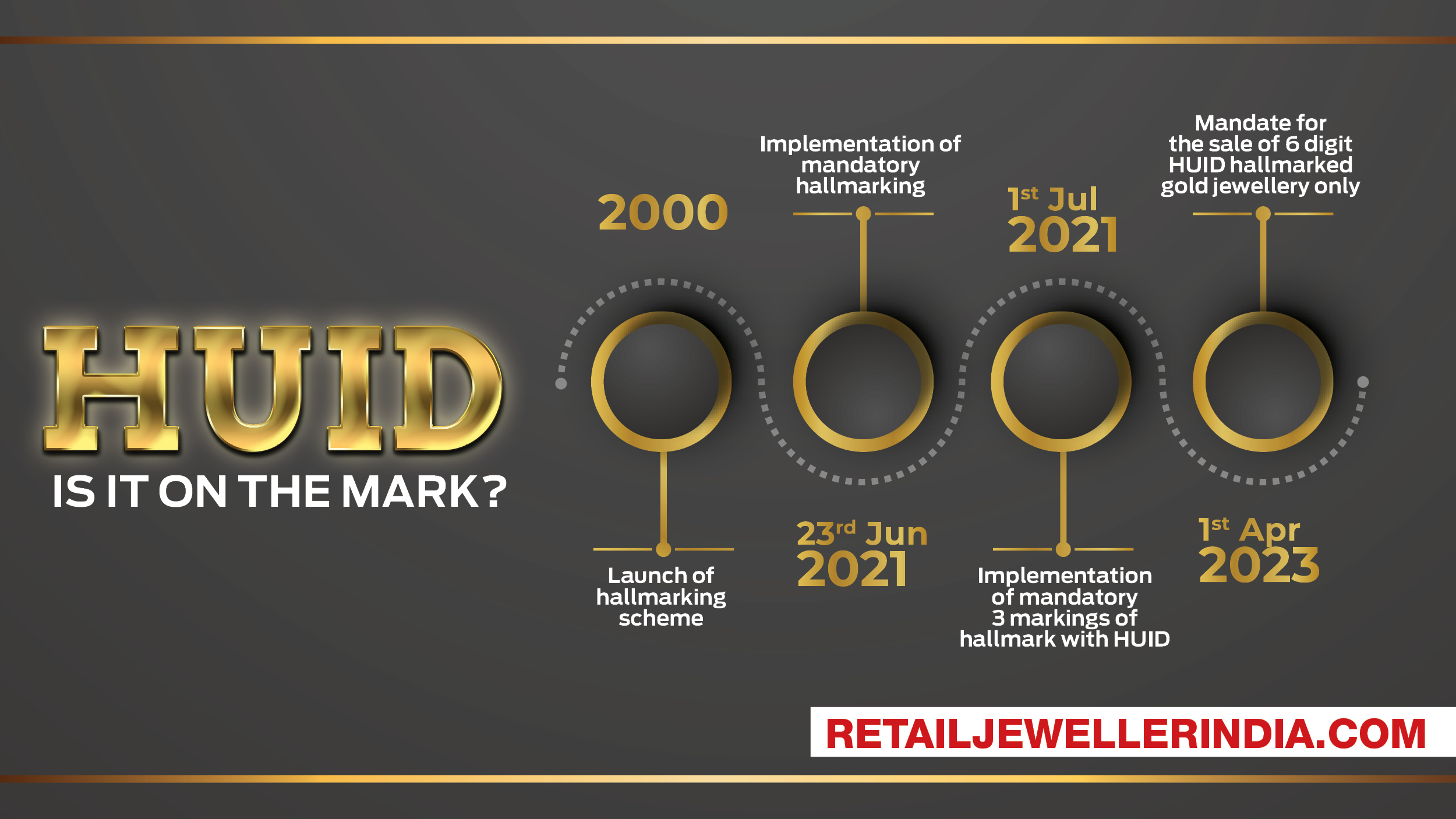Cover Feature
HUID – Is it on the mark?

The regulators have been making strides in improving hallmarking standards since 2000. The industry embraces the latest mandate of selling only HUID-based hallmarked jewellery in the spirit of positive transformation.
Still, it remains wary of providing too much transparency that breaks the principal notion of a jeweller’s exclusive ownership of a design backed by the laborious process of innovation, creation and crafting, as well as the implicit promise of the newness of a design.
The Retail Jeweller explores the paradox of HUID transparency and the roadblocks to building it as the gold standard for authenticity
Soma Bhatta
with inputs from Srabana Lahiri
On April 1, 2023, India’s gems and jewellery industry crossed a new milestone in its journey to becoming a more reputable industry by embracing a new regime prohibiting the sale of hallmarked gold jewellery or gold artefacts without a 6-digit alphanumeric Hallmark Unique Identification Number (HUID). Jadau, Kundan and Polki jewellery are exempt from hallmarking.
The 6-digit HUID was introduced on 01 July 2021. Now the hallmark consisted of 3 marks viz, BIS(Bureau of Indian Standards) logo, article purity and six-digit alphanumeric HUID.
At the time of introducing HUID, the BIS website explained: under the voluntary scheme of hallmarking, the hallmark on each piece was the same: BIS logo, purity, AHC mark and Jewellers mark. This system was prone to be misused; hence, it was decided to automate the functioning of the Assaying hallmarking centres (AHCs) by introducing a new system of HUID generated by the system and laser marked. However, until 31st March 2023, the old hallmarked jewellery (with four marks without HUID) was also permitted to be sold along with three marks with 6-digit HUID-marked jewellery.
Mandating accountability
Despite voluntary hallmarking being first introduced in 2000, the number of jewellers registered with BIS until it introduced mandatory hallmarking on June 16th, 2021, was dismal.

While hallmarking was voluntary, as per BIS data, in 2018-2019, the maximum number of hallmarked jewellery was 4.49 crore, and the number of registered jewellers was 26,668. However, after hallmarking became mandatory, the number has progressively increased to 10.3 crore hallmarked jewellery pieces and 1,53,941 registered jewellers in 2022-23. That’s a whopping 477 per cent jump in registered jewellers in five years.
“It demonstrates how jewellers continued to operate dubiously despite the govt. introducing voluntary hallmarking twenty-three years ago,” says Pradeep Kothari, Owner of Karan Kothari Jewellers, Nagpur.

In the current scenario, many jewellers question the logic of getting the old BIS hallmarked inventory (with four marks) recertified with HUID and demand extended periods for making the transition. The four marks for hallmark date back to the period before July 2021 when HUID got compulsorily in the markings.
The published text dated 4th March 2023, on the website of the Press Information Bureau, clarifies lucidly the critical reason why jewellers can no longer sell jewellery without HUID: More than a year and nine months were given to jewellers to clear their stock of their 4-digit hallmarked articles. However, the simultaneous sale of two types of hallmarked jewellery by the jewellers was creating confusion in the mind of the typical consumer.
According to Kothari, there is more to it than meets the eye. The govt., he says, ‘is aware of the malpractices in the industry’. Commenting on how jewellers have deliberately evaded compliance, Kothari says,

“Many jewellers have been unlawfully getting new inventory BIS hallmarked with four marks. Also, there are instances of jewellers applying the same HUID on several pieces which sell in cash. The customer will never know if the piece’s purity is adulterated”
Pradeep Kothari, Owner, Karan Kothari Jewellers, Nagpur
He adds that the govt. had no choice but to tighten the noose to clean up the industry and protect the consumer.
Kothari does not see any problem in the industry transitioning to the new phase of compulsory HUID hallmarking. In an ideal situation, a retailer sells out a piece within two years or melts it. In the worst-case scenario, “Max 25 per cent of the inventory will be aged two or more years, which will be BIS hallmarked and now must be stamped with HUID. I don’t see that to be a big challenge.”
The govt. has given additional time to jewellers to sell their old stock of gold jewellery or gold artefacts with old ‘four marks hallmarking’ till June 30, 2023, which they had declared before July 1, 2021-the date on which the 6-digit hallmarking ID (HUID) was introduced in the country. “This has provided much relief to genuine jewellers (who have already declared their 4-digit stocks),” says Rakesh Kumar, Chairman of India Jewellers Forum.
Powering consumers
The HUID number assigned to each piece is now fully traceable. “It is similar to a blockchain system that builds traceability of the product,” says Kothari. It tracks the transfer of the piece from manufacturing to the point of sale.
According to a tweet on the BIS’s official Twitter account, one can check the authenticity of hallmarked jewellery using the ‘verify HUID’ feature on the BIS Care App. It further explains ‘How to check the authenticity of gold jewellery using BIS Care app’. The app is available on Android and iOS. It provides information about the jeweller who got the article hallmarked, their registration number, the purity of the article, the type of article, and details of the hallmarking centre which tested and hallmarked the piece. Using this information, a typical consumer can verify the purchased article by matching it with its type and purity.
Additionally, “there is an aggressive consumer awareness campaign across media channels, encouraging consumers to authenticate the purity of gold purchased by exercising this option,” says Mohit Anand, Owner of Harsahaimal Shyamlal Jewellers, Badau, UP. The govt. authorities have spent Rs 10 crore on promoting the new guidelines for Hallmarking.
It is already beginning to impact the way customers buy jewellery. There are several instances of ‘customers who never even asked about hallmarking, now enquiring about HUID and verifying the codes on the BIS app,” says Gopikrishna Manepally, MD, Manepally Jewellers, Secunderabad, who has set up a special desk where customers are assisted for better understanding of how to verify the details on the app.

Following in the footsteps of Malabar’s ‘The Golden Truth’ campaign (initiated by The Time of India) launched towards the end of 2022 that aggressively champions against ‘BAD GOLD’, many jewellers are taking this as an opportunity to establish their integrity by releasing advertisements about the virtues of buying HUID hallmarked gold.

“We have introduced a campaign making consumers aware of HUID (at our stores) and promoting an offer for exchange of their old jewellery for HUID jewellery”
Suhas Rao, Managing Director of Bhima Jewellery

Direct-to Consumer
While the transparency afforded by HUID was welcomed, what raised hackles was customers getting visibility of the entire supply chain, down to the date of hallmarking and the manufacturer’s name.
In the Economic Times report on the HUID in 2022, the Department of Consumer Affairs stated, ‘It is a safe system that doesn’t jeopardise data privacy or security.’ The current provisions of hallmarking verification do precisely the opposite.
With customers able to see the vendor’s name in the BIS app, there are concerns that customers could bypass retailers and directly buy from them. However, Subhash Kamath, Owner of Abharan Jewellers, believes that “while customers may get the impression that they can go to the source vendor and buy jewellery cheaper, that scenario is not as ‘plug and play’ in nature as it seems.”
Echoing the opinion, Prabhat Shekhar of Manoharlal Saraf Jewellers, Delhi, says,

“Retailers offer robust buyback and exchange policies and extend many lifetime services that a manufacturer may not”
Prabhat Shekhar, Direcor of Manoharlal Saraf Jewellers, Delhi
Although most in the industry are secure in the knowledge that a manufacturer rarely risks his relationship with B2B clients, who are large buyers, by catering to their customers, the misgivings regarding vendor transparency may not be entirely misplaced.
Many b2b businesses are exploring opportunities in the b2c market. Anand believes such vendors may be tempted to attend to customers enquiring from them surreptitiously.

“Many manufacturers have active social media pages showcasing their products, participate in b-2-c exhibitions and do private exhibitions. It won’t take long for customers to connect with such sources”
Mohit Anand, Owner of Harsahaimal Shyamlal Jewellers, Badau, UP
Retail markets in manufacturing centres have another unique challenge. Many manufacturing companies are also reputed retailers and share the same high street with their trade clients.

“I buy from a manufacturer with a showroom opposite my store. Under such circumstances, it is hard to explain to the customer as they are familiar with both”
Hiren Zinzuwadia, Owner of Zinzuwadia Jewellers, Ahmedabad
Of more significant concern is the risk of losing the brand’s allure, which is often intrinsically linked to the idea of the brand’s exclusive ownership of a design backed by the laborious process of innovation, creation and crafting.
Although the industry bodies are appealing to the authorities for hallmarking at the final point of sale (and not the first), jewellers have already trained their staff to respond to predictable and challenging questions.

“Our staff is explaining to customers about the vendor sources visible to the customers. However, it is tricky as we always claimed full ownership of the piece regarding design and manufacturing”
Milan Shah, Director of Kalamandir Jewellers, Surat

Tracing Competition
In the vicious circle of scrutiny, retailers too can trace rival jewellers’ suppliers and validate the claims of their suppliers.

“A rival jeweller can easily walk into my showroom, buy a piece of jewellery and trace the manufacturer of my exclusive collections. These are issues that the BIS must address to ensure the industry is moving in the right direction”
Dr Nawal Agarwal, Owner of Birdhichand Ghanshyamdas Jewellers, jaipur
There is an adage in business circles, ‘Business secrets are competitive advantages, and our vendor secrecy is the bedrock of our success,” he adds. The newly enabled traceability invades trade secrecy.
Eager and curious to authenticate one of his existing suppliers, Anand discovered an unpleasant truth. “To my dismay, he is not a manufacturer but only a trader. I am now directly buying from the manufacturer who supplies to him and gaining more margin,” he confesses honestly.
OUT-OF-DATE
Another unique problem is the disclosure of the date on which the product is hallmarked, “Showing it means the retailer will have to keep going back and doing a fresh HUID every year, which makes no sense,” says Suvankar Sen, MD CEO, Senco Gold and Diamonds. So, my request to the authorities is to record the data by all means but show the details relevant to the end consumer.
It is common for jewellers to stock inventory as old as two to three years and try liquidating it over time. But, in today’s luxury fashion world, the promise of the newness of a design is implicit, and no consumer will knowingly enjoy buying designs marked as last year’s. The experience of purchasing a not-so-recent design undoubtedly diminishes the pleasure of owning it. Retailers are perturbed by the idea of showing the date recorded at the time of hallmarking and worry about coming across as behind the times.
The industry is vociferous about the need to maintain the secrecy of information that may not be material to the end consumer.
Colin Shah, Ex-chairman of GJEPC, founder of Kama Jewelry and a core member of the think tank for hallmarking, lends a fresh perspective to the subject. “Even the reputed laboratories incorporate dates on the certificate issued for diamonds, and so does every commodity in India manufactured and going through the BIS, the national standards body for consumer empowerment.”
On being asked about the disclosure to customers, he says.

“Consumer groups, which were a part of the panel, voiced their opinion for this change and that a customer must know the age of the product they are purchasing. While it does affect our business and our product is different it will drive the industry towards higher productivity in inventory management. ”
Colin Shah, Ex-chairman of GJEPC, founder of Kama Jewelry & member advisory commitee for hallmarking
Adding, Administering Assaying centres
While the laws and penalties are getting harsher, the support system regarding access to assaying centres and other administrative support still needs to be improved.
There are only 1395 operative AHC centres (2022-23) across 288 districts where hallmarking is mandated. “As organised players penetrate the hinterlands, the accessibility of hallmarking centres becomes crucial,” says Sen.

There are entire states without a single hallmarking centre, not to mention cities and smaller towns. Amongst others, states such as Manipur, Nagaland, Mizoram and Sikkim do not have a single BIS hallmarking centre. State capital like Guwahati has just one hallmarking centre to cater to the entire city.
Not just the number of centres, there should be accountability at these centres too, feels Saurabh Gadgil, MD & CEO, PNG Jewellers. In the last few years, there have been instances of BIS raiding hallmarking centres operating without a license (stamping gold jewellery with BIS hallmarks) and seizing spuriously hallmarked gold from licensed assaying centres.
In the larger governance context, the matter gets complex if we consider the regulatory framework for hallmarking. The BIS authorities regulate the quality standards maintained by assaying centres and jewellers. And that BIS is also the licensing authority poses a challenge in itself. As per industry sources, many centres are owned by the family of BIS officials or individuals in their close circuit. And then there are those owned by family members of jewellers.
On condition of anonymity, a jeweller explains how he owned AHC until the govt. changed its policy restricting hallmarking from AHCs owned by ‘blood relations’ in 2013-2014. “I passed on the ownership to one of my family members, and now he operates the centre.”
Even with mandatory HUID, jewellers see slight advantage as hallmarking standards vary at different centres. According to Kamath,

“Jewellers with low-quality standards continue to thrive, and the purpose is not served unless BIS ensures hallmark centres upgrade their standards. For now, to customers, it would look like even the cheating players are doing something “ethical” by having HUID.”
Subhash Kamath, Owner of Abharan Jewellers, Udupi
However, he is glad fake hallmarking would stop since the customer can check if the code is legitimate.
When asked about the new regime and its governance mechanism, the jeweller says, “The systems are now linked in real-time, and officers are getting stricter. An honest inspecting officer will know in minutes if there is any malpractice. It is no longer easy to evade the system,” he adds. Earlier, both intent and systems were weak.

“The success of HUID is linked to quality hallmarking, so it is imperative to keep the AHC under strict continuous CCTV monitoring and validate testing by X-ray fluorescence (XRF), which is a widely accepted technology”
Rakesh Kumar, Chairman of India Jewellers Forum
MARGIN OF ERROR
Besides deliberate cheating, there are cases of erroneous hallmarking at the AHCs.

“22-carat jewellery may be hallmarked by mistake as 18-carat, or the number may not tally with the master ledger. In some cases, mistakes are happening. We have a random re-checking system whereby we reduce the percentage of errors”
Suvankar Sen, MD CEO of Senco Gold and Diamonds, Kolkata
A retailer is nothing but the trust he reposes, and a well-intended retailer cannot risk his decades of well-earned reputation. Senco strives for perfection by re-checking the numbers allotted by the hallmarking centres. “We have a random re-checking system whereby we reduce the percentage of errors. However, still errors do happen, and we are working towards perfection.”
Sen advises that human errors must be factored in, and the government and their representatives must exercise sound judgement acknowledging the intent before holding someone guilty.
As per the guidelines, the AHC must return the item to the jeweller if it falls below the expected quality standard. Therefore, “Once hallmarked, if there is a difference in purity, the responsibility of the AHC should be considered too,” opines Verma.

Regarding accountability, one of the answers to the FAQs on the BIS website explains: Among manufacturers, wholesalers, distributors and retailers, the one who has got the article hallmarked is responsible for penal action in case of failure of the hallmarked sample. Also, the assaying and hallmarking centre, which has hallmarked the article, is equally accountable for disciplinary action in case of failure of the hallmarked selection. Yet, the industry worries about unjust persecution and verdicts.
TOWARDS TOTAL TRANSPARENCY
Meanwhile, there is increased confidence in gold, thanks to HUID. ‘The business keeps increasing despite increasing gold price,’ says Kothari. There’s also soaring confidence in hallmarked jewellery. According to Anil Talwar, Managing Partner, Talwarsons Jewellers, Chandigarh,

“The youth don’t want to buy anything that’s not hallmarked. The confidence that people, especially the young generation, have in buying hallmarked jewellery is immense”
Anil Talwar, Managing Partner, Talwarsons Jewellers, Chandigarh
In the spirit of positive transformation, many jewellers are proactively getting hallmarking on jewellery below 2gm and ensuring the HUID appears on the customer invoice. “While the Government has made it mandatory to get jewellery weighing more than 2 grams hallmarked, we are getting HUID for our jewellery below 2 grams,” says Sen. Though not mandated by the govt.,
According to Gopikrishna Manepally, MD, Manepally Jewellers, Secunderabad

“HUID is now integrated into our ERP system from where we generate the barcodes for the product. Correspondingly, all the customer invoices mention the HUID number”
Gopikrishna Manepally, MD, Manepally Jewellers, Secunderabad
For greater ease of operation and for HUID to pick up and succeed,

“All HUID hallmarked items must be sent by AHCs with a barcode so jewellers can quickly inward the goods, and capture HUID into their ERP systems”
Vinod Haygriv, MD & CEO, C.Krishniah Chetty and Sons, Bengaluru

“Retailers across the industry have appealed to the Government that the hallmark should be at the final point of sale, i.e. the retailer, and not the wholesaler or manufacturer. That will solve most of the issues surrounding HUID,”
K Srinivasan, Chairman and Managing Director of Emerald Group, Coimbatore
In the meantime, several retailers have issued letters of authority to their manufacturing partners for doing the HUID under their name. However, much of the purchase in gold is from ready inventory (available at wholesalers or manufacturers) and in the new system, the facility of transferring the HUID number to the retailer has been withdrawn, causing severe issues for those buying ready inventory. “HUIDs must be transferable to the ultimate seller, and the client must see the final seller information, not the intermediaries, says Haygriv.
Although the industry is aligned with the authorities in spirit and intent, it voices the overarching need for trade secrecy in regard to the date of hallmarking and supply chain. The industry principally agrees with the authority’s need to capture the data for legitimising and authenticating the hallmarking; but it vehemently opposes the sharing of undue information in the public domain, which can be misused and is immaterial to the end-consumers buying decision. This level of traceability of the product is disconcerting the jewellers.
Striving for greater authenticity at the origin, the government is considering making HUID mandatory at BIS-approved gold refineries, or imported bullion, from July 1, 2023, and for refineries in unorganised sectors melting old gold jewellery and making bullion from them, likely from Jan 1, 2024. Many in the industry are also keen on extending hallmarking to kundan, jadau and polka items currently exempted from HUID.
Along with rules, there should be benefits, too, feels Sen. “If the government builds the system to create more transparency, it should help the industry with credits and loans and facilitate consumers to buy jewellery simultaneously.”
Overall, the whole 6-digit HUID initiative is a great move to build confidence in the minds of consumers, taking India to a new degree of excellence in quality, transparency and trust. Backed by strong governmental regulation, the high-quality control benchmark will instil faith in buyers – tourists and domestic.

It is the ultimate promise of a ‘Made in India’ jewellery to foreign tourists and buyers in India”
Saurabh Gadgil, MD & CEO, PNG Jewellers, Pune
It is envisaged that HUID numbers will be mandated on customer bills requiring jewellers to compulsorily sync the HUID with the billing process, which is presently not the case, and mandatory hallmarking will be extended to every country district shortly, moving the Indian jewellery industry towards one and the highest gold standard of authenticity and transparency. A move that may augur well for the industry racing to maximise the potential of the country’s growing economy and its (vigilant) young consumers.
The Retail Jeweller India Magazine
Read more about HUID:

 Personal Opinion2 weeks ago
Personal Opinion2 weeks agoBuy-back on gemstones to be on par with gold; A fear of return on the investment, more among high-end clients: Ankur Anand, Harsahaimal Shiamalal Jewellers

 Maverick Greenhorn1 month ago
Maverick Greenhorn1 month agoSegmenting retail approach to boost business performance

 Exclusive4 weeks ago
Exclusive4 weeks agoPrasad Jewellers’ Gold Bar Challenge fulfils multi-channel engagement goals, attracts young customers

 Daily News2 weeks ago
Daily News2 weeks agoTBZ – The Original launches its first store in Jaipur

































